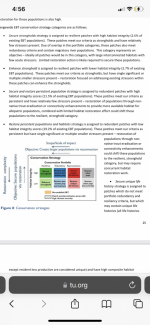I said cross reference stocking list with natural reproduction list. I would rather brown trout streams not be overharvested either. Brookies vs. browns is an entirely different debate. The one in question is the impact of harvest/stocked fish on wild trout, and that's what I was speaking to.
If you want to know my head from a conservation standpoint. Brookies are #1. The most important conservation target. However, wild brown trout streams are also worth preserving, and managing them as wild brown trout streams is better than managing them as put and take streams. If a stream is already managed as wild trout, and we're arguing over whether we should take steps to favor brookies. Well, I'd say first that is a GOOD problem to have. And the next question is what is the likelihood of success?
i.e. if it's primarily a wild trout stream. Prefer we don't stock over them at all. If we have to, stock rainbows, and say no harvest of brookies and browns.
Heck, do away with the complicated section approach, where one section is managed as wild trout, one as stocked trout, another as DHALO, etc. Keep it simple, get away from the "section" approach and go to a "species" approach. C&R fishing allowed year round, everywhere. We stock only rainbows, so ALL brookies and browns are wild. Harvest is allowed on only rainbows. Here is where we put them, and the harvest season, creel limits, etc.
Have a few select streams where you want to remove browns to benefit brookies? GREAT!!! Those become special reg sections. Hey public, we're trying to remove browns from this specific stream. Here's your chance to harvest browns. Posters go up, etc. No limit on size, no creel limit on brown trout. Have at em, we want you to. But brookies remain protected...
I don't get why the fish commission thinks the public isn't smart enough to tell the difference between trout species. We ask them to distinguish between walleye and sauger, muskie and pike and pickerel, etc. With different bag limits and size limits on each. They group all trout together for simplicity? Uh. The most avid anglers struggle to figure out the section approach. Umm, lets see, it's February, this stream is stocked, but not here, can I fish? Does it matter if I'm upstream or down of the stocked area? And hey that section limit says bridge at T02#*3. Where the heck is that? My map shows no roads named T something.. lol. We argue about where and how you can fish, what you can keep, every year. Good, knowledgable anglers struggle, and it's a topic of endless argument on fishing forums of what you're allowed to do and what you aren't!!! Meanwhile, my 7 year old can easily tell the difference between a rainbow trout and a brook trout.... People who have never wetted a line in their entire lives know the difference.




